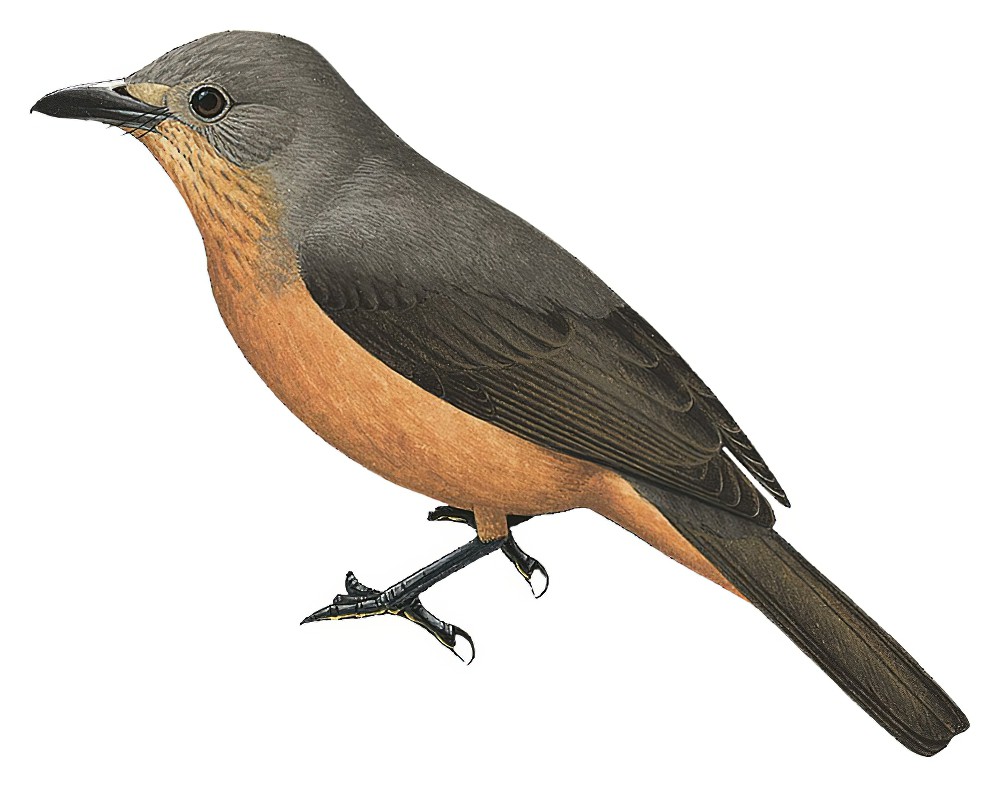Bower’s Shrikethrush / Colluricincla boweri

Bower's Shrikethrush
SCI Name:
Protonym: Collyriocincla boweri Proc.Linn.Soc.NewS.Wales 10 p.244
Taxonomy: Passeriformes / Pachycephalidae / Colluricincla
Taxonomy Code: bowsht1
Type Locality: Cairns, Queensland.
Author: Ramsay, EP
Publish Year: 1885
IUCN Status: Least Concern
DEFINITIONS
COLLURICINCLA
(Pachycephalidae; Ϯ Grey Shrikethrush C. harmonica) Gr. κολλυριων kolluriōn thrush-sized bird mentioned by Aristotle and Hesychius, not further identified, but in ornithology considered to be a shrike (cf. genus Collurio Kaup,1829, shrike); Mod. L. cinclus thrush < Gr. κιγκλος kinklos unidentified waterside bird; "Genus. COLLURICINCLA*. Rostrum forte, sub-elongatum, compressum, rectum, culmine apicem versus gradatim arcuato: mandibula inferiori prope apicem fortiter emarginata: naribus ovalibus subobliquis, membrano partim clausis, setis plumulisque obtectis: rictu setis parce instructis. Alæ mediocres rotundatæ: remigibus, prima brevi, tertia quarta quinta et sexta fere æqualibus longissimis, septima breviori, secunda et octava paulo brevioribus æqualibus; tertiæ ad sextam inclusam pogoniis externis in medio paulatim latioribus. Pedes mediocres, subfortes; acrotarsiis scutellatis, paratarsiis integris; digitis mediocribus, medio longiori, halluce forti, hujus ungue subelongato forti. Cauda subelongata, æqualis. *Kολλυριων lanius, and κιγκλος turdus. This group, which by its straight and rather lengthened bill appears to come into the subfamily of Thamnophilina among the Shrikes, may probably be considered the representative in Australia of the South American Thamnophili and the African Malaconoti. From both those genera it differs in its entirely even tail; in its wings being comparatively longer, although rounded as in those genera; and in the paratarsia being entire instead of being furnished with either large but distant, or small but numerous, scales. We have been enabled to ascertain nothing of the habits of the group: but its general appearance points out the situation we at present assign it; while at the same time it has also some general resemblance to the neighbouring family of the Thrushes. The present subfamily, it is to be observed, is that which connects the Laniadæ with the last-mentioned family Merulidæ: and this approaching conformity to the Thrushes in the birds which compose the extreme and connecting group of the Shrikes is therefore to be expected. We have assigned the genus a name indicative of these approaching affinities. 1. CINEREA." (Vigors & Horsfield 1827); "Colluricincla Vigors and Horsfield, 1827, Linn. Soc. London, 15, p. 213. Type, by monotypy, Colluricincla cinerea = Turdus harmonicus Latham." (Mayr in Peters, 1967, XII, p. 36).
Var. Colluriocincla, Collyriocincla, Collyriocichla (Mod. L. cichla thrush < Gr. κιχλη kikhlē thrush).
Synon. Alphacincla, Bowyeria, Caleya, Collurisoma, Conigravea, Myiolestes, Myiophila, Pnigocichla, Umbrixos.
boweri
Capt. Thomas Henry Bowyer-Bower (1862-1886) English ornithologist, collector in Australia (syn. Calidris subminuta, Colluricincla, syn. Epthianura crocea tunneyi, syn. Malurus melanocephalus cruentatus, syn. Ninox boobook lurida, syn. Opopsitta macleayana, syn. Oreoscopus gutturalis, syn. Sphecotheres flaviventris).
UPPERCASE: current genus
Uppercase first letter: generic synonym
● and ● See: generic homonyms
lowercase: species and subspecies
●: early names, variants, mispellings
‡: extinct
†: type species
Gr.: ancient Greek
L.: Latin
<: derived from
syn: synonym of
/: separates historical and modern geographic names
ex: based on
TL: type locality
OD: original diagnosis (genus) or original description (species)












